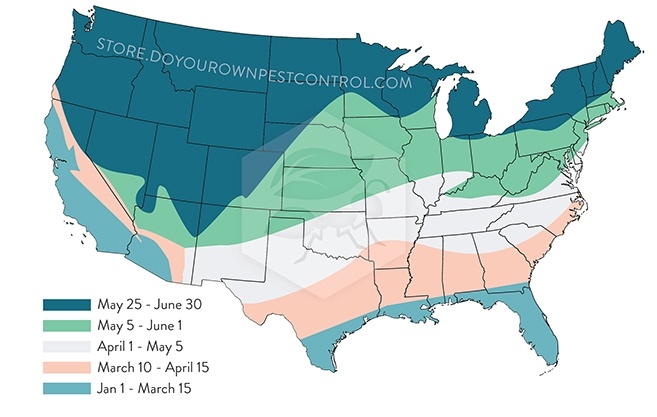what temperature should it be to apply pre emergent?
Weed Prevention using Pre-Emergent Herbicides
A guide to when to utilize pre-emergent herbicides
-
Spring Herbicide Application
-
Fall Herbicide Application
Pre-emergent herbicides, sometimes referred to as crabgrass preventives, are effective means to preclude an undesired weed trouble before it starts. This article explains pre-emergent herbicides, and when to apply them.
What are Pre-Emergent Herbicides?
Pre-emergent herbicides are chemicals that prevent undesired weeds in your backyard. They practise not forestall the germination of the seed, simply help control it so that information technology will non sprout. Due to the way these herbicides work, application timing is the nigh of import aspect of weed prevention success. If the weed has already sprouted and is visible, pre-emergent herbicides volition not solve the weed trouble. For a summary of pre-emergent active ingredients, get to Pre-emergent Herbicides
There are a few exceptions considering some chemicals include active ingredients that work as both postal service (afterwards the weed sprouts) and pre-emergent herbicides such as Dithiopyr products.
When to Use Pre-Emergent Herbicides?
Early on Jump and Autumn are the about effective times to apply pre-emergent herbicides. They can be practical throughout the year, and will yet forbid new weeds that sprout, yet most weeds sprout during bound and fall. Spring applications target different weed species than Fall applications, and then information technology is very important to know the type of weed you are trying to prevent for best results. See below for help identifying your target weeds.

Jump Herbicide Application
Leap pre-emergent herbicide applications are used to prevent summer almanac weeds. Summer annual weeds are both grassy and broad leaf types. For best results apply herbicides when the soil temperature is around 55 degrees or above for at least 36 to 72 hours (ideally this will exist two weeks before seed germination). The majority of the U.s.a. experiences these soil temperatures from March to April. Consult your local county extension service to get upwards to engagement soil temperatures in your area. Here is a map that gives a skilful idea of when to apply in the function of the land you live in.
Using granules or liquid formulations are the ii primary manners to apply herbicides. If yous apply granular pre-emergent herbicide it is very important to water the chemical into the footing because the active ingredient needs to penetrate the soil. The herbicide is trapped past the granule until it is activated by h2o. This is also true with liquid pre-emergent products because grass and other plants may trap the active ingredient keeping it from reaching the soil during the initial application.
Cardinal Takeaway
Preventing weeds like crabgrass and annual bluegrass is far easier than killing them once they are established.
Mutual Annual Summer Grassy Weeds & Mutual Almanac Summer Broadleaf Weed

Fall Herbicide Application
Autumn pre-emergent applications are designed to prevent winter annual weeds. These weeds germinate during the autumn months. Similar to spring applications, timing is very important to successfully forestall wintertime annual weeds from taking over your lawn. The best time to apply fall pre-emergent herbicides is late summertime to early fall depending on your geographic location.
Annual Bluegrass (Poa Annua) is one of the most mutual winter annual weeds. Annual Bluegrass is a hardy weed, and may require multiple applications over sequent seasons to accomplish an acceptable level of control. Fall weeds being to germinate when soil temperatures starts to dip below 70 degrees (soil temperatures near 50 degrees). The best time to utilize is the when the daytime highs drop to the mid-70s for most iii to five days in a row.
Since a pre-emergent application will non last through the following summer, make a pre-emergent application tardily leap or early summer (see Bound Herbicide Application map).
Common Winter Annual Weeds
- Poa Annua (Annual Bluegrass)
- Common Chickweed
- Prickley Lettuce
- Grassy Weed Command
Pre-Emergent Product Recommendations
- How-do-you-do-Yield Weed and Grass Stopper-This granulated per-emergent is handy when you don't want to spray, and adopt to use a spreader.
Cool-flavour Grasses: 2.4 - ix.ii lbs. per one,000 sq. ft Warm-season Grasses: iii.five - 9.two lbs. per one,000 sq. ft.
- Prodiamine 65 WDG-Prodiamine 65 WDG is the most economical mode to cover a large area. Use 1 to 2.25 tablespoons per 1000 foursquare anxiety.
- Agrisel Pendi Hydrocap-Works the same fashion as Prodiamine 65 WDG, but can be bought in smaller units, roofing a smaller area. For turfgrass applications (absurd flavor and warm flavour grasses) apply i.1 to ane.6 oz. per 1000 sq. ft.
- Dimension 2 EW Dimension ii EW with Dithiopyr is a pre-emergent with some post-emergent activity for crabgrass (if yous take hold of the crabgrass growth within x-14 days later sprouting). Utilise 0.l to 0.73 ounces in a minimum of 1 gallon of water per 1000 square feet.
- Dithiopyr xl WSB-Is another Dithiopyr product, only more than economical. Up 20 oz per acre; 0.46 oz per 1,000 square feet. This is a proficient pick for 25 or larger spray tanks.
- *Click on the products beneath to view rates and tolerant turfgrass usage.
Source: https://diypestcontrol.com/pre-emergent-herbicide-guide.htm
0 Response to "what temperature should it be to apply pre emergent?"
Post a Comment